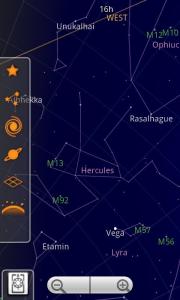Our ‘10 Fun Facts about Labware” blog post was actually pretty popular (the internet loves lists), so we thought we’d do a sequel to talk about other oddities of the labware world. Here we go
10) Condensers are all about the surface area and Hollywood loves them – So you’ve got some gas, right? And you need to get it back to liquid state, right? Because that gas is gonna disspiate if you just let it run free, but how can you get it cool enough to turn liquid in a limited amount of space and have that liquid end up in a flask or something else? The answer is a Condenser!
Condensers (particularly Graham condensers) are popular in Hollywood depictions of laboratories as they have that neat swirly tubing inside another tube. Run some colored liquid through them and they look awesome!
But why all that swirly tubing? Well it turns out that you need a decent amount of cooling to turn a gas into liquid. So the curling tubing is actually trying to expose the gas in the tube to as much of the cooling liquid that fills the outer tube. That liquid (usually just water) is fed in from the top and drains out the bottom as it would otherwise get too warm to cool down that gas before it exited the tubing.
Hollywood, BTW, loves showing condensers because it is neat to watch liquid swirl through all that spiral tube, even if it would serve no purpose as shown.
9) Attachment sizes and what they mean – Every now and then you might encounter a piece of labware that has some numbers associated with it. 24/40, 19/22 , and many other sizes. So what does this mean?
 Well this is a measurement to see if one piece of labware will attach with another. The sizes denote ground glass openings on the flask, condesner, etc and therefore should be compatible with a labware with the same kind of measurement. When these attach, the ground glass openings provide enough friction to keep them connected but not so connected that they cannot be seperated easily.
Well this is a measurement to see if one piece of labware will attach with another. The sizes denote ground glass openings on the flask, condesner, etc and therefore should be compatible with a labware with the same kind of measurement. When these attach, the ground glass openings provide enough friction to keep them connected but not so connected that they cannot be seperated easily.
As to the actual numbers and what they mean – the first number corresponds to the diameter at the end of the ground glass zone (so 24 is 24mm) while the second number corresponds to the length of the ground glass zone (so 40 is 40mm).
8) Evaporation flasks – So the opposite of condensation is evaporation. Naturally there are a lot of ways and reasons to evaporate liquids, the most common being to simply boil it. But sometimes you need a less…energetic way of evaporating liquids (volitiles like alcohols, for example, may not  appreciate flames). So one common method is to use a rotary evaporator:
appreciate flames). So one common method is to use a rotary evaporator:
Rotary evaporators are fairly complex systems that pretty much just speed up (and contain) what would otherwise happen to low-boiling points liquids exposed to room temperatures. You’ll sometimes see special evaporation flasks with oval shapes: these are designed to get the maximum surface area on the heat section of a evaporation system.
7) Filtration:
Sometimes you may spot a Erhlemeyer Flask with a tube sticking out of it.  This is called a filtering flask. It uses a couple of other pieces of equipment to operate: First a felxible tube is attached to the glass tube and then to a pump (powered or hand operated). A stopper with a hole is put into the top of the flask which goes to a filtering funnel known as a Buchner Funnel. Some filter paper is placed into this funnel. You then activate your pump (which means you have some hard work if a hand pump is being used). The liquid in need of filtration is then slowly added inot the top of the funne;. The drop in air pressure pulls the water through the filter paper and funnel leavs behind any solids or other materials.
This is called a filtering flask. It uses a couple of other pieces of equipment to operate: First a felxible tube is attached to the glass tube and then to a pump (powered or hand operated). A stopper with a hole is put into the top of the flask which goes to a filtering funnel known as a Buchner Funnel. Some filter paper is placed into this funnel. You then activate your pump (which means you have some hard work if a hand pump is being used). The liquid in need of filtration is then slowly added inot the top of the funne;. The drop in air pressure pulls the water through the filter paper and funnel leavs behind any solids or other materials.
6) Volumetric Flasks:
 If there is a ‘piece of labware most likely to be repurposed’ it is the Volumetric Flask. With its long stem and round bottom it is possible they beat out ‘small beakers turned into shot glasses’ by being turned into flower vases. But the volumetric flask actually has an important role in chemistry. If you need to make a solution of a particular Molar (a measurement of how much of a reagent is in a set quantity of solution) the best way is to use a Volumetric Flask. Measure out the quantity of reagent for the solution you are making, and add it to the measured solution in the flask. IT is as accurate as you can get and the best way to mix said solutions. The Volumetric Flask combines the accuracy of a graduated cylinder with the mixing ability of a normal flask (Such as a Ehrlenmeyer flask or round-bottom flask)
If there is a ‘piece of labware most likely to be repurposed’ it is the Volumetric Flask. With its long stem and round bottom it is possible they beat out ‘small beakers turned into shot glasses’ by being turned into flower vases. But the volumetric flask actually has an important role in chemistry. If you need to make a solution of a particular Molar (a measurement of how much of a reagent is in a set quantity of solution) the best way is to use a Volumetric Flask. Measure out the quantity of reagent for the solution you are making, and add it to the measured solution in the flask. IT is as accurate as you can get and the best way to mix said solutions. The Volumetric Flask combines the accuracy of a graduated cylinder with the mixing ability of a normal flask (Such as a Ehrlenmeyer flask or round-bottom flask)
5) Separatory funnels:
This odd-looking inverse teardrop shaped piece of labware may, oddly enough, be more familiar to some readers  of this blog post as they are often used in beer brewing and similar hobbies. Separatory Funnels are used when you need to seperate two liquids from each other (such as oil and water, yeast and water, etc.). The differing densities of liquids well seperate out inside the funnel (some shaking may be involved). Once sepearted the more dense liquid can be drained out the tube in the bottom, leaving the less dense liquid remaining in the flask.
of this blog post as they are often used in beer brewing and similar hobbies. Separatory Funnels are used when you need to seperate two liquids from each other (such as oil and water, yeast and water, etc.). The differing densities of liquids well seperate out inside the funnel (some shaking may be involved). Once sepearted the more dense liquid can be drained out the tube in the bottom, leaving the less dense liquid remaining in the flask.
4) Labware for a new generation (Class A Coding)
OK, so this is an issue for laboratories where critical measurements are required. As we mentioned in our previous chapter there is special labware known as ‘Class A’ labware. This is labware certified to extreme accuracy and even has to be certified, either by the batch or individually (which is more expensive). The problem is that labs may be required to show that their labware is certified for one reason or another. The certification, however is usually a piece of paper that gets filed away or lost, leaving the lab struggling to find the right papers and possibly contacting the manufacturer. So what solution is there? A modern one where your Smartphone can check your labware’s certification. That’s right, Class A labware’s certification will soon be bar-encoded!
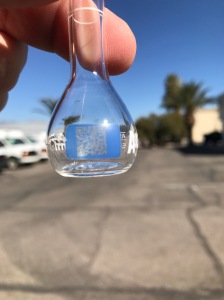
Now rather than running to the file cabinet you can simply catch the barcode on your Smartphone and your certification will come right up! Couldn’t be easier!
3) Lipless and Lipped Test tubes
So test tubes come in two forms – with a lip (which helps with pouring) and lipless (which….has no real advantage). Plastic test tubes typically are lipless to reduce expense. In fact it is not certain why lipless test tubes are made except that many folks buy them for no-laboratory uses. Most of the ones we have sold a the store are repurposed – usually to hold flowers (its a thing).
2) Types of plastic labware and what they do
So we discussed plastic labware in the previous chapter. But there are actually several types of plastic that are used in labware. Polyproylene (PP), for example is economical and very hard to break. Unfortunately is it also not as transparent as glass and may be hard to read the markings. Polymethylpentene (PMP) is as clear as glass so is much easier to read. Unfortunately, it is also much more expensive than PP and may be more  brittle. It becomes a question of priorities.
brittle. It becomes a question of priorities.
1) Plastic Pipettes and their uses
Little plastic pippetes are another item in heavy use outside the laboratory. These little soft plastic droppers come in a wide variety of sizes and shapes. Some are measured, some are not. They can come sterile or not, etc.
In the lab and medical field they are used to draw small, controlled quantities of liquid. In medicine they are used to grab a sample of blood from a source (they are not used to draw blood, obviously).
Outside the lab? The limits are people’s imagination! Gold Hunters use them to draw the small flakes out of liquid known to have gold flakes.. Bakers use pipettes to both insert fillings into cupcakes and cakes (to make patterns they could not do otherwise) or even just fill them with coloful icing and stick them into the cake to make an attractive ‘bulb’ cake ornament. In addtion to icing, liquers can be used, or other flavorings. Food artisans have taken to using pipettes to ‘inject’ fruit with various flavorings as well!
www.spectrum-scientifics.com
 There were even charts or lists produced to show what the various types of crystals indicated the weather would be. An example from Admiral Fitzroy
There were even charts or lists produced to show what the various types of crystals indicated the weather would be. An example from Admiral Fitzroy








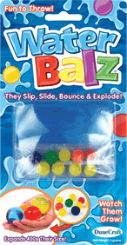





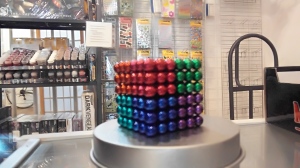


 Well this is a measurement to see if one piece of labware will attach with another. The sizes denote ground glass openings on the flask, condesner, etc and therefore should be compatible with a labware with the same kind of measurement. When these attach, the ground glass openings provide enough friction to keep them connected but not so connected that they cannot be seperated easily.
Well this is a measurement to see if one piece of labware will attach with another. The sizes denote ground glass openings on the flask, condesner, etc and therefore should be compatible with a labware with the same kind of measurement. When these attach, the ground glass openings provide enough friction to keep them connected but not so connected that they cannot be seperated easily. appreciate flames). So one common method is to use a rotary evaporator:
appreciate flames). So one common method is to use a rotary evaporator: This is called a filtering flask. It uses a couple of other pieces of equipment to operate: First a felxible tube is attached to the glass tube and then to a pump (powered or hand operated). A stopper with a hole is put into the top of the flask which goes to a filtering funnel known as a Buchner Funnel. Some filter paper is placed into this funnel. You then activate your pump (which means you have some hard work if a hand pump is being used). The liquid in need of filtration is then slowly added inot the top of the funne;. The drop in air pressure pulls the water through the filter paper and funnel leavs behind any solids or other materials.
This is called a filtering flask. It uses a couple of other pieces of equipment to operate: First a felxible tube is attached to the glass tube and then to a pump (powered or hand operated). A stopper with a hole is put into the top of the flask which goes to a filtering funnel known as a Buchner Funnel. Some filter paper is placed into this funnel. You then activate your pump (which means you have some hard work if a hand pump is being used). The liquid in need of filtration is then slowly added inot the top of the funne;. The drop in air pressure pulls the water through the filter paper and funnel leavs behind any solids or other materials.


 brittle. It becomes a question of priorities.
brittle. It becomes a question of priorities.
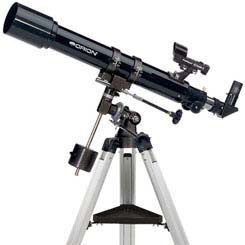 skipped. This can result in a frustrating experience for a budding young astronomer who may give up their new hobby prematurely. This can be avoided if you only take the time and a few precautions to make certain you get the baby steps out of the way without too much tripping and falling.
skipped. This can result in a frustrating experience for a budding young astronomer who may give up their new hobby prematurely. This can be avoided if you only take the time and a few precautions to make certain you get the baby steps out of the way without too much tripping and falling. magnifications on a short focal length telescope only see a little under 1 arc degree of the sky. This is a tiny portion of the sky so hoping to find an object with just the eyepiece is really hard to do. There is a reason why almost all telescopes come with a finder scope. So make sure to align it (During the daytime per suggestion #1) . If your telescope comes with a red-dot finder instead of an optical finder scope, be certain to carefully align that as well during the daytime – and don’t forget to switch it off! A dead battery in a red dot finder is nobody’s friend.
magnifications on a short focal length telescope only see a little under 1 arc degree of the sky. This is a tiny portion of the sky so hoping to find an object with just the eyepiece is really hard to do. There is a reason why almost all telescopes come with a finder scope. So make sure to align it (During the daytime per suggestion #1) . If your telescope comes with a red-dot finder instead of an optical finder scope, be certain to carefully align that as well during the daytime – and don’t forget to switch it off! A dead battery in a red dot finder is nobody’s friend.